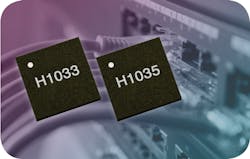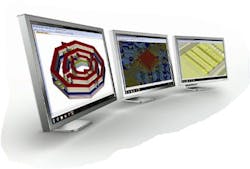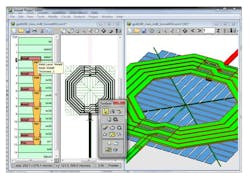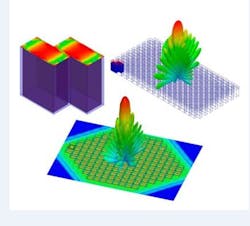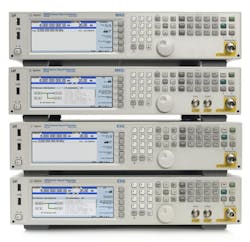Next month, European Microwave Week (EuMW; www.eumweek.com) 2012 is scheduled to be held in Amsterdam, The Netherlands. From October 28 through November 2, conference-goers will be able to take place in this international event. Although smaller than the International Microwave Symposium (www.ims2013.org), EuMW provides a useful venue for microwave and RF firms looking to introduce their wares before year-end. With a three-day exhibition, many companies are planning to showcase developments ranging from high-performing discrete components to software that promises to tackle tough and time-consuming design challenges.
In the components area, attendees can expect to once again see an uptick in gallium-nitride (GaN) components. For example, M/A-COM Technology Solutions (www.macomtech.com) will be showing products like its GaN in plastic and GaN smart pallets for aerospace and defense radar applications. The company also will be spotlighting modulator drivers and transimpedance amplifiers for 40G and 100G applications, a switch-limiter for radar applications, and a 42-GHz Smartset chipset for point-to-point wireless backhaul.
In addition, NXP Semiconductors (www.nxp.com) will be showing its breadth of GaN products. Targeting wireless infrastructure, the firm’s showcase will include a full-band, multicarrier GSM power amplifier (PA); a compact, high-power WCDMA PA; and a compact micro-cell PA [monolithic-microwave-integrated-circuit (MMIC) Doherty]. The firm also will be touting the advantages of its high-power LDMOS S-band PA.
To show the breadth of its engineering offerings, AR (www.ar-worldwide.com) will be showing how engineers can achieve high linear output power to 50+ W from 1 to 6 GHz in one assembly. The firm’s hybrid solid-state power modules, benchtop, and rack-mounted units demand just 0 dBm input power to achieve their rated output power.
Two surface-mount-technology (SMT) -packaged clock generators will be showcased by Hittite Microwave Corp. (www.hittite.com). The HMC1033LP6GE and the HMC1035LP6GE expand the company’s clocks and timing portfolio by offering programmable frequency synthesis from 25 MHz to 2.5 GHz (Fig. 1). Such synthesis is available in both integer and fractional relationships to the generators’ reference clocks. The devices promise impressive performance in both jitter and noise. The HMC1033LP6GE, for example, offers typical phase jitter of 99 fs RMS with phase noise of -163 dBc/Hz while consuming 0.64 W.
1. These SMT-packaged clock generators offer programmable frequency synthesis from 25 MHz to 2.5 GHz in both integer and fractional relationships to their reference clocks.
With software almost as prominent on a microwave show floor as hardware, it is no surprise that some impressive software launches will be spotlighted at EuMW. Take AWR Corp.’s (www.awrcorp.com) newest product: a three-dimensional (3D) finite-element-method (FEM) electromagnetic (EM) simulation and analysis software called Analyst (Fig. 2). Because Analyst is integrated within the AWR Design Environment of Microwave Office, the engineer can move from circuit concept to full 3D EM verification of bumps, bond wires, ribbons, and more with a single mouse click. With 3D EM and circuit design in one integrated workflow, engineers can focus on designing, optimizing, and tuning for the electrical performance of their MMICs, RF PCBs, and/or modules instead of being concerned with the task of drawing.
2. This 3D finite-element-method (FEM), electromagnetic (EM) simulation and analysis software will be making its debut at EuMW.
Sonnet Software (www.sonnetsoftware.com) will be previewing Sonnet Suites Release 14, which is expected to be available at year-end. This release features enhanced speed for Sonnet’s 3D-planar EM simulation engines as well as new technology to automate the setup of EM model extraction. The graphical user interfaces (GUIs) have been tuned for faster response over remote host and VM host networks, which is increasingly important in enterprise computing environments.
In addition to allowing more central-processing-unit (CPU) cores to be used in parallel over the previous release, the Sonnet meshing algorithms have been tuned to yield faster simulations. Large-scale via arrays and via bar structures are more efficiently meshed for the accelerated simulation of deep-node, silicon-RFIC stacked-metal inductors and interconnects. A Technology Manager also has been added to the Sonnet Project Editor, providing an intuitive graphic interface for creating or editing the process stackup (Fig. 3). Finally, Sonnet’s Co-calibrated Ports provide accurate internal port calibration, enabling error-free access to internal connections for large passive circuits. RF engineers using the Cadence Virtuoso (www.cadence.com) or Agilent Technologies’ Advanced Design System (ADS; www.agilent.com) platforms also will notice increased automation for Sonnet’s integration products.
3. Among the enhancements in a new software release is a Project Editor, which provides an intuitive graphic interface for creating or editing the process stackup.
A trio of software enhancements will be shown at the ANSYS (www.ansys.com) booth. By harnessing multicore and networked processing power, a number of high-performance-computing (HPC) improvements to the High-Frequency Structure Simulator (HFSS) software promise to solve larger, more complex EM and signal-integrity problems. According to the firm, its enhanced multi-threading technology delivers faster solve times while the new Spectral Decomposition Method distributes a multiple-frequency solution over networked compute cores (thereby enabling the very fast extraction of frequency sweeps). For their part, the MPI-based Domain Decomposition methods purport to efficiently leverage the random-access memory (RAM) across a network of computers to expand simulation capacity.
Integration improvements also will be showcased by ANSYS. HFSS can now be operated using the Cadence Design Systems layout-based user interface. This customized environment automates the process of preparing layout data for analysis using HFSS. All geometry, material properties, boundary conditions, and ports are set up automatically and reliably. Also worthy of notice is the firm’s Advanced Finite Antenna Array. Using an approach built upon the ANSYS Domain Decomposition technology, antennas can be defined and simulated in an efficient, scalable, and rapid manner by leveraging their repetitive nature (Fig. 4).
4. Here, all finite effects of an antenna array are included in the analysis with no approximation, such as neglecting edge effects or assuming equivalent input impedances for all ports.
The test and measurement booths always have a strong presence at any microwave show. At this year’s EuMW, Agilent Technologies will be showing its latest FieldFox handheld analyzers (see Microwaves & RF next month for a full review). These devices are equipped to handle tasks ranging from routine maintenance to in-depth troubleshooting—even at extreme temperatures. Also on hand will be the X-Series signal generators, which range from 9 kHz to 6 GHz in a product family spanning the higher-end MXG to the cost-effective EXG (Fig. 5). These instruments vow to address the challenges of increased interference, data throughput, and signal quality in aerospace/defense and wireless communications.
5. This family of signal generators, which ranges from 9 kHz to 6 GHz, promises to help designers overcome the challenges of increased interference, data throughput, and signal quality in aerospace/defense and wireless communications.
Copper Mountain Technologies (CMT; www.coppermountaintech.com) will be exhibiting its line of Virtual vector network analyzers (VNAs) in frequency ranges to 8 GHz. The firm will be demonstrating its PLANAR R54, a laboratory-grade but pocket-sized vector reflectometer. It also will be disclosing some details of the Virtual VNA products on the horizon, which include a four-port model and an expanded selection of frequency ranges.
At the National Instruments (www.ni.com) booth, the focus will be on how test and measurement instrumentation can be greatly enhanced with software. Among the products being shown will be the NI PXIe-5644R vector signal transceiver performing IEEE 802.11ac measurements. Conference-goers also can check out how the NI PXIe-5667 spectrum-monitoring receiver is used for over-the-air measurements while the new NI 5791 software-defined radio (SDR) targets the prototyping of next-generation communications systems.
Maury Microwave Corp. (www.maurymw.com) will be showcasing its active and hybrid-active harmonic load-pull solutions as well as its patent-pending noise-parameter solution. Also on hand will be the BILT pulsed-IV/RF compact transistor modeling system and a selection of component products including the following: mechanical VNA calibration kits, metrology, the Test Essentials and ColorConnect coaxial and waveguide adapters, and the Stability phase-stable cable assemblies.
On the topic of cables, W.L. Gore & Associates (www.gore.com) created the GORE PHASEFLEX Microwave/RF test assemblies to reduce total testing costs for production test environments in the wireless-infrastructure market. These assemblies, which will be shown at EuMW, are engineered to withstand the frequent torque, bending, and shaking common to test and manufacturing-floor environments. Also on hand will be the firm’s cable-based antennas, which were created to help airlines provide Internet access to passengers.
The GORE Cable-Based Antennas promise to improve signal propagation without increasing the amount of hardware required on the plane. The antennas, which are engineered fluoropolymers in a lightweight coaxial cable, are simply installed along the length of the cabin ceiling. With signal propogation occurring every meter along the antenna, passengers are assured reliable access to in-flight entertainment, Internet servers, and e-mail accounts —regardless of their location in the plane. Passengers’ signals are transmitted via a signal network computer and outside antenna to satellites, which connect to the worldwide network. Ideal for both wide-body and single-aisle passenger aircraft, this antenna sends and receives signals in frequencies ranging from 400 MHz to 6 GHz. It is therefore compatible with numerous communication standards.
Away from the trade-show floor, conference-goers will be learning about the state of the art in microwave technology in applications at the 42nd European Microwave Conference (EuMC). Also happening this week is the 9th European Radar Conference (EuRAD 2012). This Radar Conference is the major European forum for both the present status and future trends in radar technology, system design, and applications. Rounding out the conference offerings is the two-day 7th European Microwave Integrated Circuits (EuMIC) Conference. Between the conferences and the exhibition, EuMW will once again provide a glimpse into emerging and existing cutting-edge microwave developments.
About the Author

Nancy Friedrich
RF Product Marketing Manager for Aerospace Defense, Keysight Technologies
Nancy Friedrich is RF Product Marketing Manager for Aerospace Defense at Keysight Technologies. Nancy Friedrich started a career in engineering media about two decades ago with a stint editing copy and writing news for Electronic Design. A few years later, she began writing full time as technology editor at Wireless Systems Design. In 2005, Nancy was named editor-in-chief of Microwaves & RF, a position she held (along with other positions as group content head) until 2018. Nancy then moved to a position at UBM, where she was editor-in-chief of Design News and content director for tradeshows including DesignCon, ESC, and the Smart Manufacturing shows.
